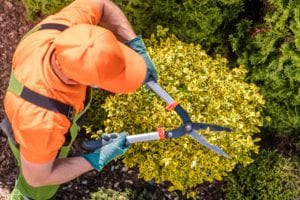At long last, it’s spring! Many of us have eagerly awaited the growing season, especially over the long, cold winter months. If you’re ready to get your yard ready for warmer days, this guide is for you.
Know your zone
Let’s start with a note about spring in the Midwest: as you probably already know, it can be fickle. It’s essential to know your planting zone. The US Department of Agriculture created a 13-zone Hardiness Zone Map, which helps to guide gardeners and plant professionals on when and what to plant based on where they live. Most of Northern Illinois is Zone 5B, with a frost-free date of May 1-10 and a first frost date of September 21-30. These are averages, so it’s also wise to check the Illinois Water Survey’s map of the latest spring frost dates. (Not in Illinois? Check the Hardiness Zone Map above).
Spring tree care tips
Have trees on your property? They are already starting to come out of dormancy if they are deciduous (or lose their leaves each fall). This starts as early as February, as the trees prepare for the growing season ahead. You’ll first notice small buds, then early leaf growth, and then (typically in later April and early May) the trees in full flower.
Early spring is a great time to check on tree health with these tips:
- Inspect your trees before they leaf out. Look for cracked, broken, or diseased branches—and prune them to protect your trees and property.
- Were any of your trees damaged by winter storms, snow, or ice? If so, early spring is a good time to remove them. Contact a certified arborist and tree care professionals.
- Adding to your landscape? Make plans to plant new trees on your property once weather permits, to give young trees time to grow and establish a strong root system
Fun fact: this year, Arbor Day is celebrated on Friday, April 28.
Spring lawn care tips
Early spring is the ideal time to give your lawn a strong start to the season. Take the time to give your mower a tune-up if it has been sitting in the garage over the winter.
A solid spring lawn care checklist includes:
- Clean-up, raking, and evaluating bare patches
- Preparing and seeding the soil to address bare spots
- Mow high early to give grass time to establish a healthy root system
- Fertilize at the time of the first mowing, and consider applying a 3-in-1 turf builder to control weed growth
See this article for more details on spring lawn care.
Spring garden tips
Do you have flowerbeds? Plant a vegetable garden or patio containers? You’ll want to make time to prepare these as well.
After a long winter, you might need to edge and clean up your flowerbeds, and it’s easiest to do this when the soil is soft in the spring. Use a sharp-edged garden spade to redefine the borders. Examine perennials and shrubs for signs of damage over the winter. Apply mulch to a depth of 1-3” around the base of perennials and shrubs—but not on top of them. Be sure to include your trees in mulching too—but don’t pile mulch around the bark itself. Leave a couple of inches for the tree to breathe. Mulch suppresses weed growth and helps plants and trees retain moisture better in the hot months ahead.
For vegetable gardens, turn over the soil in early spring and consider adding enhancements like compost and manure. Cold-tolerant vegetables like carrots, lettuce, and beets can be sowed directly in the soil, even before the last frost date. For flowering plants like tomatoes and peppers, and most cutting flowers, wait until after the last frost date has passed. Containers can be planted and brought into the garage or other warmer zone during frost warnings.
Spring houseplant care tips
Even your houseplants benefit from some spring plant care. Though they haven’t braved the outdoor extremes that many plants have, they have gone through a period of dormancy. Longer days and more hours of sunshine mean it’s time to up your watering frequency. Plants that have spent the summer on your windowsill might need to be moved away from direct sunlight so that their leaves don’t become yellowed or burnt. And just as you like turning your face up to the first warm rays, your houseplants do, too—so make plans to take them outside when it’s warm enough to do so.
Looking to get your yard ready for spring? Advanced Tree Care can help. Advanced Tree Care combines top-notch equipment, cutting-edge technology, and well-trained staff to provide emergency tree removal and tree maintenance services. With a presence in nine counties and two states, we work daily to provide unparalleled customer service, safety, and efficiency—as well as the expertise to beautify your landscaping and community. Advanced Tree Care isn’t just our name—it’s also our purpose!





